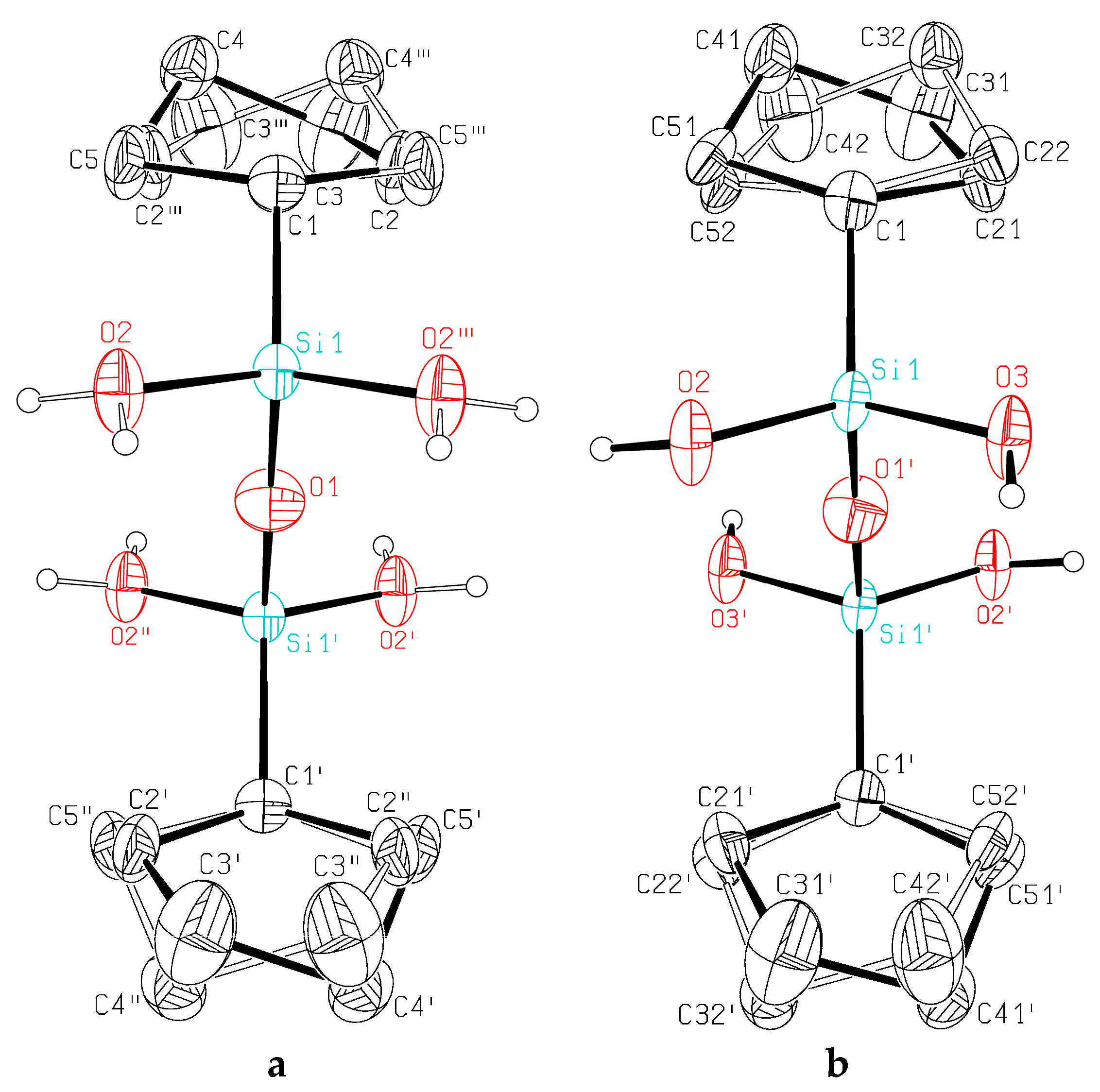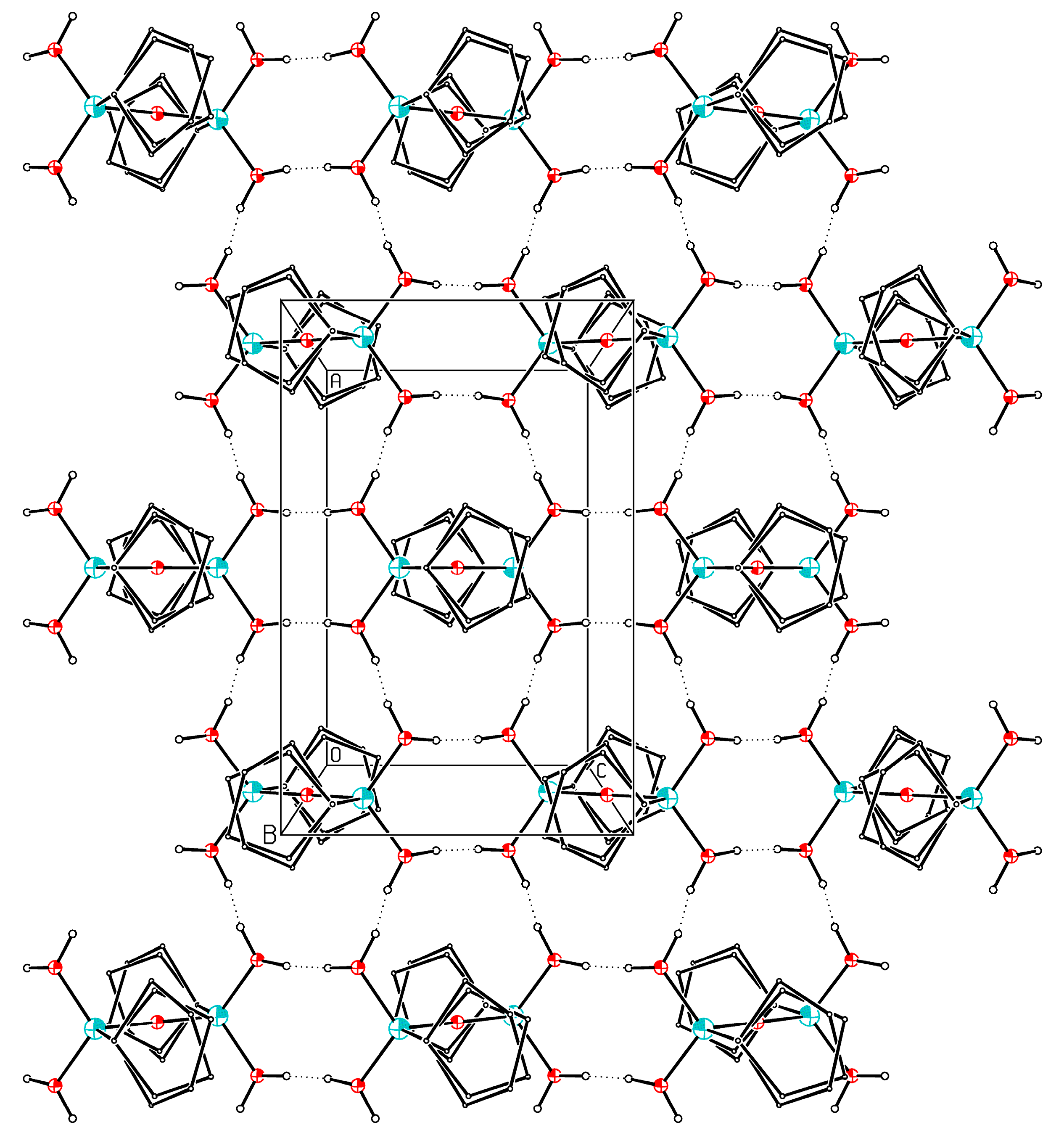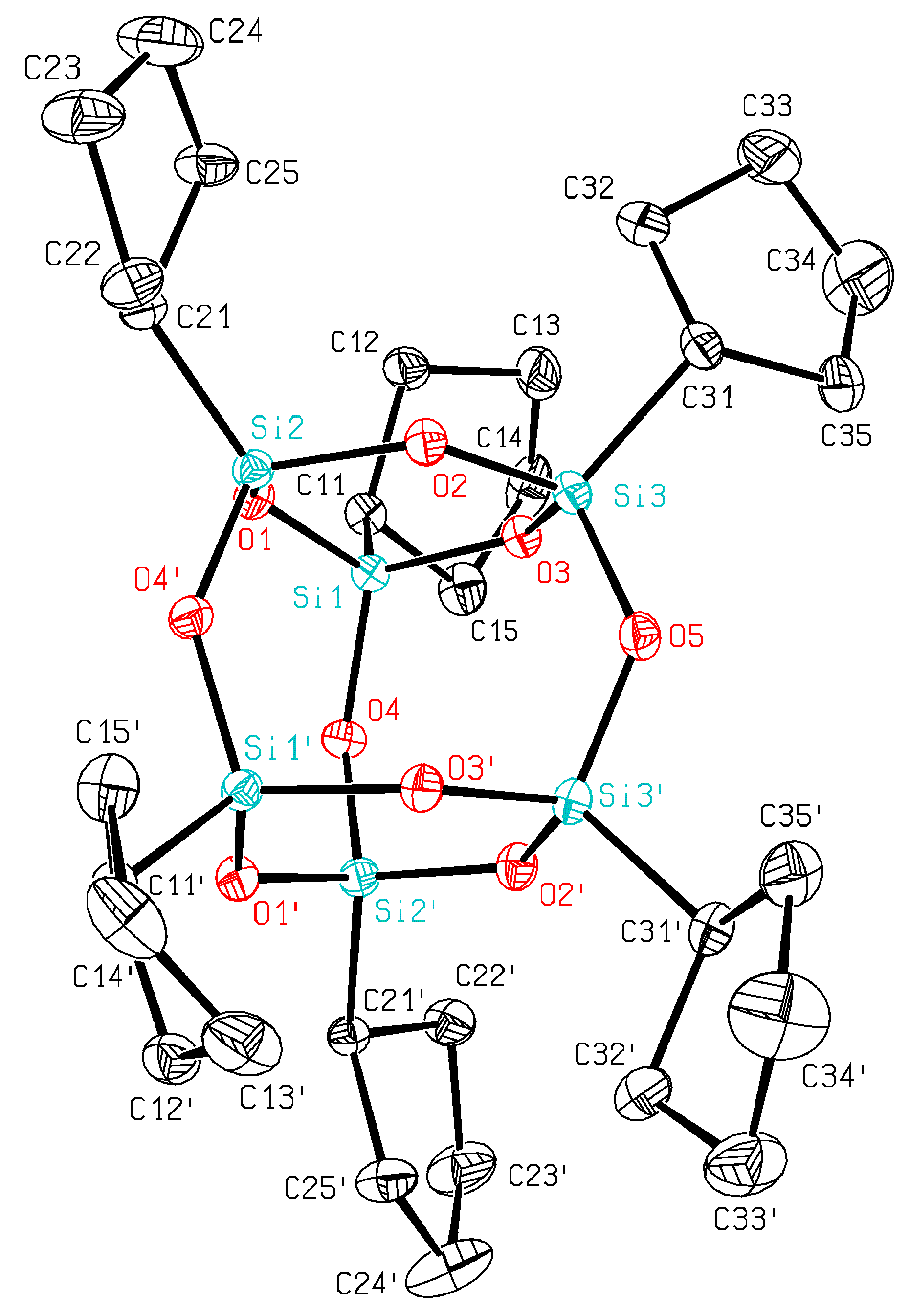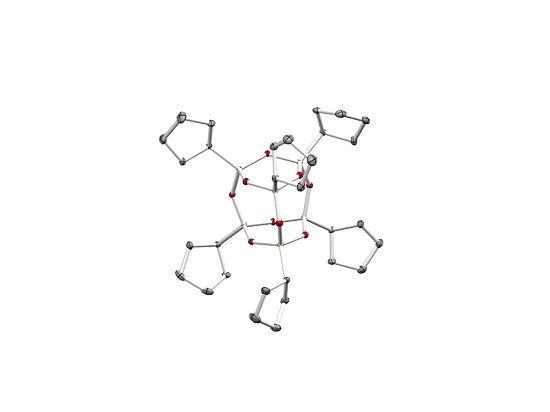Preparation and Molecular Structure of a Cyclopentyl-Substituted Cage Hexasilsesquioxane T6 (T = cyclopentyl-SiO1.5) Starting from the Corresponding Silanetriol
Abstract
:1. Introduction
2. Results and Discussion
3. Experimental Details
3.1. Synthesis of cyclopentylsilanetriol 1
3.2. Synthesis of the 1,3-Dicyclopentyldisiloxane-1,1,3,3-tetrol 2
3.3. Synthesis of Hexa(cyclopentylsilsesquioxane) 3
3.4. X-ray Crystallography
4. Conclusions
Supplementary Materials
Acknowledgments
Author Contributions
Conflicts of Interest
References
- Hartmann-Thompson, C. Advances in Silicon Science; Springer: Heidelberg, Germany, 2011; Volume 3. [Google Scholar]
- Cordes, D.B.; Lickiss, P.D.; Rataboul, F. Recent developments in the chemistry of cubic polyhedral oligosilsesquioxanes. Chem. Rev. 2010, 110, 2081–2173. [Google Scholar] [CrossRef] [PubMed]
- Janssen, M.; Wilting, J.; Müller, C.; Vogt, D. Continuous rhodium-catalyzed hydroformylation of 1-octene with polyhedral oligomeric silsesquioxanes (POSS) enlarged triphenylphosphine. Angew. Chem. (Int. Ed.) 2010, 49, 7738–7741. [Google Scholar] [CrossRef] [PubMed]
- Dittmar, U.; Hendan, B.J.; Floerke, U.; Marsmann, H.C. Functionalized octa(propylsilsesquioxanes)(3-xC3H6)8(Si8O12)—Model compounds for surface modified silica gel. J. Organomet. Chem. 1995, 489, 185–194. [Google Scholar] [CrossRef]
- Feher, F.J.; Newman, D.A.; Walzer, J.F. Silsesquioxanes as models for silica surfaces. J. Am. Chem. Soc. 1989, 111, 1741–1748. [Google Scholar] [CrossRef]
- Tuteja, A.; Choi, W.; Ma, M.; Mabry, J.M.; Mazzella, S.A.; Rutledge, G.C.; McKinley, G.H.; Cohen, R.E. Designing superoleophobic surfaces. Science 2007, 318, 1618–1622. [Google Scholar] [CrossRef] [PubMed]
- Tanaka, K.; Ishiguro, F.; Chujo, Y. POSS ionic liquid. J. Am. Chem. Soc. 2010, 132, 17649–17651. [Google Scholar] [CrossRef] [PubMed]
- Feher, F.J.; Wyndham, K.D.; Scialdone, M.A. Octafunctionalized polyhedral oligosilsesquioxanes as scaffolds: Synthesis of peptidyl silsesquioxanes. Chem. Commun. 1998, 14, 1469–1470. [Google Scholar] [CrossRef]
- Matisons, J. Applications of Polyhedral Oligomeric Silsesquioxanes; Springer: Dordrecht, The Netherlands; Heidelberg, Germany; London, UK; New York, NY, USA, 2011. [Google Scholar]
- Bassindale, A.R.; Liu, Z.; MacKinnon, I.A.; Taylor, P.G.; Yang, Y.; Light, M.E.; Horton, P.N.; Hursthouse, M.B. A higher yielding route for T8 silsesquioxane cages and X-ray crystal structures of some novel spherosilicates. Dalton Trans. 2003, 14, 2945–2949. [Google Scholar] [CrossRef]
- Bassindale, A.R.; Pourny, M.; Taylor, P.G.; Hursthouse, M.B.; Light, M.E. Fluoride-ion encapsulation within a silsesquioxane cage. Angew. Chem. Int. Ed. 2003, 42, 3488–3490. [Google Scholar] [CrossRef] [PubMed]
- Bassindale, A.R.; Chen, H.; Liu, Z.; MacKinnon, I.A.; Parker, D.J.; Taylor, P.G.; Yang, Y.; Light, M.E.; Horton, P.N.; Hursthouse, M.B. A higher yielding route to octasilsesquioxane cages using tetrabutylammonium fluoride, Part 2: Further synthetic advances, mechanistic investigations and X-ray crystal structure studies into the factors that determine cage geometry in the solid state. J. Organomet. Chem. 2004, 689, 3287–3300. [Google Scholar] [CrossRef]
- Pietschnig, R.; Spirk, S. The chemistry of organo silanetriols. Coord. Chem. Rev. 2016, 323, 87–106. [Google Scholar] [CrossRef]
- Hurkes, N.; Bruhn, C.; Belaj, F.; Pietschnig, R. Silanetriols as powerful starting materials for selective condensation to bulky POSS cages. Organometallics 2014, 33, 7299–7306. [Google Scholar] [CrossRef] [PubMed]
- Takiguchi, T. Preparation of some organosilanediols and phenylsilanetriol by direct hydrolysis using aniline as hydrogen chloride acceptor. J. Am. Chem. Soc. 1959, 81, 2359–2361. [Google Scholar] [CrossRef]
- Spirk, S.; Nieger, M.; Belaj, F.; Pietschnig, R. Formation and hydrogen bonding of a novel POSS-trisilanol. Dalton Trans. 2009, 163–167. [Google Scholar] [CrossRef] [PubMed]
- Čas, D.; Hurkes, N.; Spirk, S.; Belaj, F.; Bruhn, C.; Rechberger, G.N.; Pietschnig, R. Dimer formation upon deprotonation: Synthesis and structure of a m-terphenyl substituted (R,S)-dilithium disiloxanolate disilanol. Dalton Trans. 2015, 44, 12818–12823. [Google Scholar] [CrossRef] [PubMed]
- Hurkes, N.; Spirk, S.; Belaj, F.; Pietschnig, R. At the edge of stability—Preparation of methyl-substituted arylsilanetriols and investigation of their condensation behavior. Z. Anorg. Allg. Chem. 2013, 639, 2631–2636. [Google Scholar] [CrossRef]
- Suyama, K.-I.; Nakatsuka, T.; Gunji, T.; Abe, Y. Synthesis and crystal structure of disiloxane-1,3-diols and disiloxane-1,1,3,3-tetraol. J. Organomet. Chem. 2007, 692, 2028–2035. [Google Scholar] [CrossRef]
- Lickiss, P.D.; Litster, S.A.; Redhouse, A.D.; Wisener, C.J. Isolation of a tetrahydroxydisiloxane formed during hydrolysis of an alkyltrichlorosilane: Crystal and molecular structure of [But(OH)2Si]2O. J. Chem. Soc. Chem. Commun. 1991, 3, 173–174. [Google Scholar] [CrossRef]
- Bassindale, A.R.; MacKinnon, I.A.; Maesano, M.G.; Taylor, P.G. The preparation of hexasilsesquioxane (T6) cages by “non aqueous” hydrolysis of trichlorosilanes. Chem. Commun. 2003, 12, 1382–1383. [Google Scholar] [CrossRef]
- Unno, M.; Alias, S.B.; Arai, M.; Takada, K.; Tanaka, R.; Matsumoto, H. Synthesis and characterization of cage and bicyclic silsesquioxanes via dehydration of silanols. Appl. Organometal. Chem. 1999, 13, 303–310. [Google Scholar] [CrossRef]
- Behbehani, T.; Brisdon, H.B.J.; Mahon, M.F.; Molloy, K.C. The structure of hexa(cyclohexylsesquisiloxane), (C6H11)6Si6O9. J. Organomet. Chem. 1994, 469, 19–24. [Google Scholar] [CrossRef]
- Unno, M.; Alias, S.B.; Saito, H.; Matsumoto, H. Synthesis of hexasilsesquioxanes bearing bulky substituents: Hexakis((1,1,2-trimethylpropyl)silsesquioxane) and hexakis(tert-butylsilsesquioxane). Organometallics 1996, 15, 2413–2414. [Google Scholar] [CrossRef]
- Unno, M.; Imai, Y.; Matsumoto, H. Hexakis(2,4,6-triisopropylphenylsilsesquioxane). Silicon Chem. 2003, 2, 175–178. [Google Scholar] [CrossRef]
- Hoebbel, D.; Engelhardt, G.; Samoson, A.; Újszászy, K.; Smolin, Y.I. Preparation and constitution of the crystalline silicic acid trimethylsilyl ester [(CH3)3Si]6Si6O15. Z. Anorg. Allg. Chem. 1987, 552, 236–240. [Google Scholar] [CrossRef]
- Unno, M.; Suto, A.; Takada, K.; Matsumoto, H. Synthesis of Ladder and Cage Silsesquioxanes from 1,2,3,4-Tetrahydroxycyclotetrasiloxane. Bull. Chem. Soc. Jpn. 2000, 73, 215–220. [Google Scholar] [CrossRef]
- Lickiss, P.D.; Rataboul, F. Fully condensed polyhedral oligosilsesquioxanes (POSS): From synthesis to application. In Advances in Organometallic Chemistry; Academic Press: Oxford, UK, 2008; Volume 57, pp. 1–116. [Google Scholar]
- Wann, D.A.; Reilly, A.M.; Rataboul, F.; Lickiss, P.D.; Rankin, D.W.H. The gas-phase structure of the hexasilsesquioxane Si6O9(OSiMe3)6. Z. Naturforsch. B 2009, 64, 1269–1275. [Google Scholar] [CrossRef]




| Parameter | 2m | 2o | 3 |
|---|---|---|---|
| Formula | C10H22O5Si2 | C10H22O5Si2 | C30H54O9Si6 |
| Formular weight | 278.46 | 278.46 | 727.27 |
| Temperature [K] | 100 | 100 | 100 |
| Wavelength [Å] | 0.71073 | 0.71073 | 0.71073 |
| Crystal system | monoclinic | orthorhombic | orthorhombic |
| Space group | P21/c | Cmce | Ccce |
| Unit cell dimensions: | - | - | - |
| a [Å] | 11.5359(16) | 10.1476(5) | 16.2855(8) |
| b [Å] | 6.7079(9) | 20.7484(10) | 22.3460(11) |
| c [Å] | 10.1493(13) | 6.7022(3) | 19.6563(9) |
| α [°] | 90 | 90 | 90 |
| β [°] | 115.830(4) | 90 | 90 |
| γ [°] | 90 | 90 | 90 |
| Volume [Å3] | 706.90(16) | 1411.12(12) | 7153.2(6) |
| Z | 2 | 4 | 8 |
| Calcd. density [mg/m3] | 1.308 | 1.311 | 1.351 |
| μ [mm−1] | 0.258 | 0.258 | 0.283 |
| Θ-range for data collected [°] | 3.62–25.50 | 3.62–26.00 | 2.59–30.00 |
| Data/parameters | 1303/125 | 734/66 | 5219/213 |
| Goodness-of-fit on F2 | 1.095 | 1.159 | 1.052 |
| R1 (obsd. data) | 0.0326 | 0.03440.0346 | 0.0378 |
| wR2 (all data) | 0.0873 | 0.0903 | 0.1049 |
| Rint | 0.0235 | 0.0264 | 0.0397 |
| r.e.d. min/max [e Å−3] | −0.247/0.235 | −0.291/0.414 | −0.346/0.631 |
© 2017 by the authors. Licensee MDPI, Basel, Switzerland. This article is an open access article distributed under the terms and conditions of the Creative Commons Attribution (CC BY) license (http://creativecommons.org/licenses/by/4.0/).
Share and Cite
Kahr, J.; Belaj, F.; Pietschnig, R. Preparation and Molecular Structure of a Cyclopentyl-Substituted Cage Hexasilsesquioxane T6 (T = cyclopentyl-SiO1.5) Starting from the Corresponding Silanetriol. Inorganics 2017, 5, 66. https://doi.org/10.3390/inorganics5040066
Kahr J, Belaj F, Pietschnig R. Preparation and Molecular Structure of a Cyclopentyl-Substituted Cage Hexasilsesquioxane T6 (T = cyclopentyl-SiO1.5) Starting from the Corresponding Silanetriol. Inorganics. 2017; 5(4):66. https://doi.org/10.3390/inorganics5040066
Chicago/Turabian StyleKahr, Jürgen, Ferdinand Belaj, and Rudolf Pietschnig. 2017. "Preparation and Molecular Structure of a Cyclopentyl-Substituted Cage Hexasilsesquioxane T6 (T = cyclopentyl-SiO1.5) Starting from the Corresponding Silanetriol" Inorganics 5, no. 4: 66. https://doi.org/10.3390/inorganics5040066






